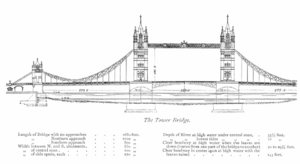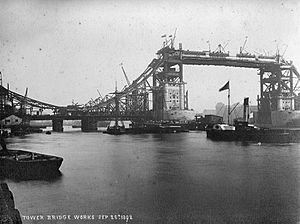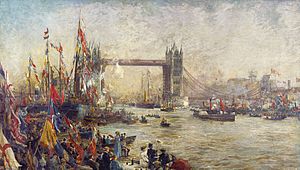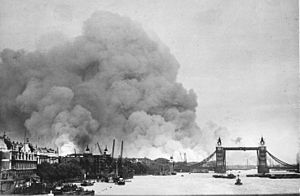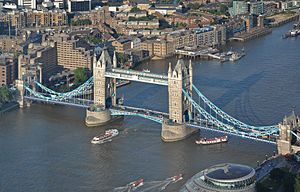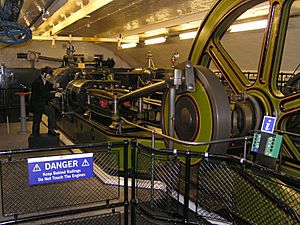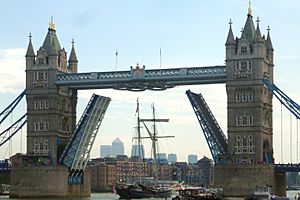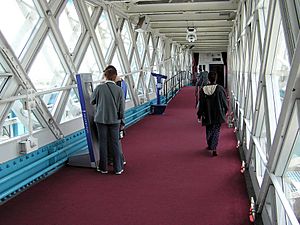Tower Bridge facts for kids
Quick facts for kids Tower Bridge |
|
|---|---|
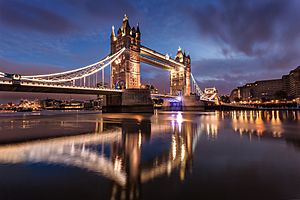
View from Shad Thames
|
|
| Coordinates | 51°30′20″N 0°4′31″W / 51.50556°N 0.07528°W |
| Carries | London Inner Ring Road |
| Crosses | River Thames |
| Locale | London boroughs: – north side: Tower Hamlets – south side: Southwark |
| Named for | Tower of London |
| Maintained by | City Bridge Foundation, City of London Corporation |
| Heritage status | Grade I listed building |
| Preceded by | London Bridge |
| Followed by | Elizabeth II Bridge |
| Characteristics | |
| Design |
|
| Total length | 940 ft (290 m) |
| Height | 213 ft (65 m) |
| History | |
| Architect | Horace Jones |
| Construction begin | 22 April 1886 |
| Construction end | 1894 |
Tower Bridge is a famous bridge in London, England. It was built between 1886 and 1894. The bridge crosses the River Thames near the historic Tower of London. It is one of London's most well-known landmarks.
Tower Bridge is special because it's a mix of different bridge types. It has parts that are like a bascule bridge (which opens up) and parts that are like a suspension bridge. Until 1960, it also had parts that worked like a cantilever bridge.
The bridge was designed by Horace Jones and engineered by John Wolfe Barry. It was built to help people cross the river in East London. At the same time, it needed to let large ships pass through to the Pool of London.
The bridge is 940 feet (290 m) long. It has two tall towers, each 213-foot (65 m) high. These towers are connected at the top by two walkways. The middle part of the bridge has two sections called bascules. These bascules can lift up to let ships go by.
Originally, the bridge opened using a powerful water system. In 1972, it was updated to an electric-hydraulic system. Tower Bridge is part of the London Inner Ring Road. About 40,000 vehicles cross it every day. You can walk or drive across the bridge for free. The towers, high walkways, and old engine rooms are now part of the Tower Bridge Exhibition.
Many people confuse Tower Bridge with London Bridge, which is about 0.5 miles (800 m) upstream. This has led to a funny story about someone buying the wrong bridge!
Contents
Bridge History
Why Tower Bridge Was Built
In the late 1800s, London's East End was growing fast. More people and businesses meant a new way to cross the River Thames was needed. But a regular bridge would block tall ships from reaching the important port area called the Pool of London. This area was between London Bridge and the Tower of London.
So, in 1875, a special committee was formed to find a solution. They looked at many ideas. Over 50 designs were sent in, but none were quite right. Finally, in 1884, they decided on a "low level bridge with mechanical openings." This meant a bridge that could open up. They chose a design for a bascule bridge, which is the type that lifts its sections.
Building the Bridge
The British Parliament approved the plan for Tower Bridge in 1885. The law said the bridge had to fit in with the look of the nearby Tower of London. It also said the bridge had to be finished within four years. Most importantly, it had to open for ships at any time, even if it delayed road traffic.
Construction began on April 22, 1886. The first stone was laid by the Prince of Wales (who later became King Edward VII). The project took eight years to complete. Many different companies worked on it. On average, 432 people worked on the site each day. More than 1,200 people worked on the bridge in total. Sadly, ten workers died during construction.
Two huge concrete foundations, weighing over 70,000 long tons (78,400 short tons; 71,123 t), were sunk into the riverbed. These supported the bridge's towers. Over 11,000 long tons (12,320 short tons; 11,177 t) of steel were used for the towers and walkways. This steel was then covered with Cornish granite and Portland stone. This stone covering made the bridge look like the Tower of London.
Horace Jones, the original architect, passed away in 1887. John Wolfe Barry took over as the main architect. He changed Jones's original brick design to the more detailed Victorian Gothic style. This made the bridge a unique landmark. The total cost to build Tower Bridge was about £1,184,000. That's a lot of money, even today!
Opening Day
Tower Bridge officially opened on June 30, 1894. The Prince of Wales and Princess of Wales were there for the ceremony. It was a very important event for the City of London.
After the official opening, the City of London Corporation held a party for the 1,200 workers and their families. They were given gifts to celebrate their hard work.
When the bridge opened, it connected Iron Gate on the north side with Horselydown Lane on the south side. Before Tower Bridge, the Tower Subway was the shortest way to cross the river. It was a pedestrian tunnel. But once Tower Bridge opened, most people used the bridge because it was free. The tunnel then closed in 1898.
The high-level walkways between the towers were originally open-air. They were meant for pedestrians to cross when the bridge was open. But they were not used much and closed in 1910. They reopened in 1982 as part of the Tower Bridge Exhibition.
Tower Bridge in the 20th and 21st Centuries
Mid-20th Century Events
During Second World War, Tower Bridge was an important target for enemy planes. In 1940, it was hit, damaging its opening system. In 1941, a bomb exploded nearby, causing more damage. A third engine was added in 1942 to make sure the bridge could still open if the others were damaged.
On December 30, 1952, a double-decker bus was crossing the bridge. The bridge started to open by mistake! The bus driver, Albert Gunter, quickly decided to speed up. He managed to jump the bus across a small gap to the other side. The conductor broke his leg, but no one was seriously hurt. The driver was given a £10 bonus for his quick thinking.
In 1960, the upper walkways were changed. They were originally cantilever bridges, but were made into suspension bridges to make them stronger. In 1974, the old water-powered system for opening the bridge was replaced with a new electric-hydraulic system.
In 1982, the Tower Bridge Exhibition opened. Visitors could explore the towers, the high-level walkways, and the old engine rooms.
Recent Times
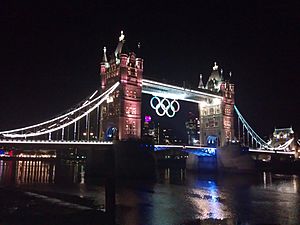
In 2000, the bridge closed for a month for repairs. A new computer system was installed to control the bridge's opening. However, this system had some problems in 2005 and caused the bridge to get stuck sometimes.
In 2008, a big £4 million renovation started. The bridge was repainted blue and white. Before this, it was red, white, and blue for Queen Elizabeth II's Silver Jubilee in 1977. The renovation was finished in 2010.
For the 2012 Summer Olympics in London, the west walkway of the bridge was turned into a "Live Music Sculpture." Thirty musicians played music there. After the Olympics, the Olympic rings on the bridge were replaced with the emblem for the 2012 Summer Paralympics.
In 2016, Tower Bridge was closed to road traffic for three months for major maintenance. This included fixing the wooden deck and the lifting parts. It was still open for ships and pedestrians.
How Tower Bridge Works
Bridge Structure
Tower Bridge is unique because it combines three types of bridges. The parts from the river banks to the main towers are suspension bridges. The middle part that opens is a bascule bridge. The high-level walkways were originally cantilever bridges but became suspension bridges in 1960.
The main towers have a steel frame covered with granite and Portland stone. The total length of the bridge, including the parts leading up to it, is 940 feet (290 m). The road across the bridge is 60 feet (18 m) wide, except at the opening part, where it is 49 feet (15 m) wide.
The central part of the bridge is 200 feet (61 m) wide. It is split into two bascules, or leaves. Each bascule is 100 feet (30 m) long and weighs about 1,070 tons. They are balanced so they can be lifted in about five minutes. They can open up to an angle of 82 degrees.
The two side spans are each 270 feet (82 m) long. The pedestrian walkways are 143 feet (44 m) above the river at high tide. You can reach them by lifts and stairs.
Opening System
The bridge used to open using a system powered by pressurized water. Two large steam engines pumped water into special tanks called accumulators. This pressurized water then powered the machinery that lifted the bascules.
The entire system, including the gas lighting, was installed by William Sugg & Co Ltd. In 1974, the old system was mostly replaced with a new electric-hydraulic system. Now, oil is used instead of water.
Signals and Rules
When the bridge first opened, there were special rules for ships. During the day, red signals on the bridge towers showed if the bridge was closed. At night, red lights meant closed, and green lights meant open. In foggy weather, a gong was sounded.
Ships also had to show signals. During the day, a black ball meant they needed the bridge to open. At night, two red lights meant the same. If the bridge could not open, a different signal was shown. These signals were also repeated further downstream to warn boats.
Some of the old signal controls are now in the Tower Bridge museum.
Crossing the Bridge
Road Traffic
When Tower Bridge first opened, about 8,000 vehicles crossed it every day. The bridge would open for ships about 17 times a day, stopping road traffic for about six minutes each time.
Today, Tower Bridge is still very busy. More than 40,000 people (drivers, cyclists, and walkers) use it every day. It's part of the London Inner Ring Road.
To protect the bridge, there's a speed limit of 20-mile-per-hour (32 km/h) and a weight limit of 18-tonne (20-short-ton) for vehicles. Cameras check vehicle speeds and weights. Drivers who break the rules get fines.
Pedestrians
You can walk across the bascule bridge when it is down for cars. But ships always have priority. This means road and pedestrian traffic must wait when the bridge opens for a ship.
When the bridge first opened, about 60,000 pedestrians used it daily. In 2014, the pedestrian walkways on the high level were updated with glass floors. You can now look down through the glass to the road and river below! Lifts take people up to and down from these walkways. The upper walkways are part of the Tower Bridge Exhibition. There is a fee to visit the exhibition.
River Traffic
The bascules of Tower Bridge are now raised about a thousand times a year. River traffic is less busy than it used to be, but it still gets priority. Today, you need to give 24 hours' notice if you want the bridge to open for your vessel. There is no charge for ships to pass through.
Visiting Tower Bridge
The Tower Bridge Exhibition is a popular attraction. It's located inside the bridge's towers, the high-level walkways, and the old Victorian engine rooms. The exhibition uses films, photos, and interactive displays to show how and why Tower Bridge was built. You can see the original steam engines that once powered the bridge. They are in the Engine Rooms under the south end of the bridge.
There is an admission fee to enter the exhibition. You start at the ticket office on the west side of the North Tower. From there, you can take stairs or a lift up to the high-level Walkways. These walkways offer amazing views of the city, the Tower of London, and the Pool of London. The glass floors are a highlight! From the South Tower, you can go down to the Victorian Engine Rooms.
In 2019, Tower Bridge had 889,338 visitors. It was one of the most visited attractions in England that charged an admission fee.
Interesting Facts and Incidents
Tower Bridge is a very famous landmark. The City of London calls it "London's defining landmark." Some people in the early 1900s didn't like its design, but it has become a beloved symbol of London.
Many people confuse Tower Bridge with London Bridge. There's a popular story that in 1968, an American named Robert P. McCulloch bought the old London Bridge and moved it to Arizona. The story says he thought he was buying Tower Bridge! But this has been denied by McCulloch and others.
There's even a smaller copy of Tower Bridge in Suzhou, China. It looks similar but doesn't have the lifting parts.
Tower Bridge is also on the badge of the Greater London Scout Region.
Famous Incidents
- On August 10, 1912, a brave pilot named Francis McClean flew his plane between the bascules and the high-level walkways. He became famous for this stunt.
- On April 5, 1968, a Royal Air Force pilot flew his jet fighter, a Hawker Hunter, without permission through Tower Bridge. He flew very low and fast under the walkway. He was later removed from the RAF.
- On May 19, 1997, the motorcade of U.S. President Bill Clinton was split in half when the bridge opened. President Clinton was running late, and the bridge opened on schedule for a ship. This caused some worry for his security team!
- On August 19, 1999, a man named Jef Smith, who was a "Freeman of the City of London," herded a flock of two sheep across the bridge. He was using an old right that allowed freemen to do this.
Images for kids
See also
 In Spanish: Puente de la Torre para niños
In Spanish: Puente de la Torre para niños


